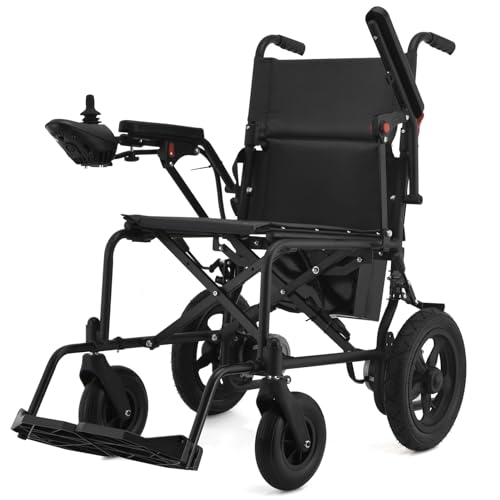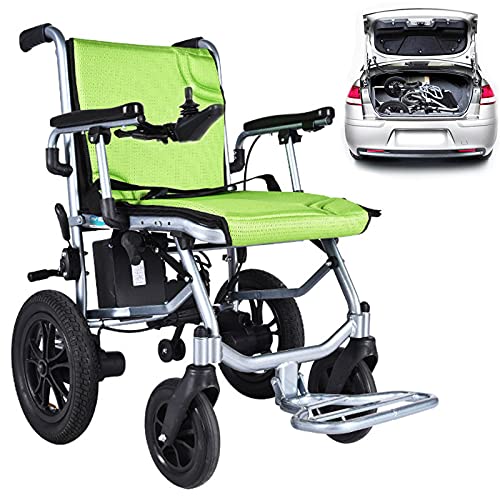electric small wheelchair Wheelchair With Joystick
Power wheelchairs with joysticks can significantly improve independence and ease of use. Standard joysticks are not able to accommodate the unique characteristics of hand impairment.
This study examined the efficacy and satisfaction of customized power wheelchair joysticks that were made using 3D printing technology. Evaluation was conducted using the modified power-mobility inside driving assessment (PIDA), National Aeronautics and Space Administration Task Load Index, and Psychosocial Impact of Assistive Devices Scale.
Control
The control system of a power chair includes two important components: the joystick and the electronic. The standard joysticks are placed on the left or the right side of the wheelchair, while more advanced rehab chairs feature swing-away mounts that allow the joystick to slide into the middle of the seat.
The way in which a joystick will be mounted and used is crucial to its effectiveness for a customer. For instance, if an individual has significant tremors, it is vital to ensure the joystick is designed in such a way that these actions will not cause accidental activations of the chair. The standard EPW joysticks are typically proportional input devices that respond to the amount of deflection on the gimbal to control the movement of the chair (similar to an automobile accelerator pedal or video game controller).
However, there are now several different control options for power wheelchairs that require very only a little force to activate. Switch controls, sip-and puff controls as well as head arrays and the chin controls are all there. Some of these controls require an additional interface to connect to the wheelchair. However, most of them work with new joysticks that integrate Bluetooth into the handles.
Some of the standard wheelchair joysticks come with a screen to display the current status of the system and provide feedback to the user. This is especially useful for those with visual or cognitive impairments. Other advanced joysticks come with the ability to control many different devices like environmental controls and even a TV or tablet.
Regardless of the technology, a joystick can only be as useful as it is easy for the user to use. It is therefore crucial to think about the dimensions of the buttons and their position on a joystick to make them easy to access. Also, it is essential to think about the sensitiveness of the joystick which can be adjusted to a range of levels based on the needs of each individual client.
Comfort
A joystick-controlled powerchair offers many benefits that aren't available with a manual chair. They reduce fatigue caused by operational factors and permit longer travel distances than manual-operated counterparts. They can also be used in places that are smaller and have more challenging terrain than a manual one, such as uneven surfaces or slopes in the outdoors. This additional freedom allows users to experience a new freedom of movement and feeling of freedom.
A variety of different power wheelchairs are offered with an array of options. The number of bells and whistles on the particular model will be contingent on the user's needs and wants. Some of the most commonly used features include:
Controls on an
electric wheelchair 25 stone wheelchair equipped with a joysticks can be modified to fit individual needs. This includes the kind of knob, ball or handle and the manner in which it is mounted. Some joysticks can be found at the end of the armrest of the driver's seat and others are positioned on the front or rear of the seat to make it easier for attendants to reach. Certain joysticks can be placed on the side for those with limited shoulder range or muscle weakness.
Other features are more personal to you such as the size and style of the joystick display screen. Certain models are backlit or have colors that make it easier for those with poor vision to read. Other models have additional modes that provide audio or visual cues for navigation. They can also offer clocks, odometers, as well as battery charge indicators.

Another important aspect of the joystick is how well it can be maneuvered in a tight turning radius. The best-performing models will have a tight turning radius, which makes it easier to maneuver obstacles in small areas, such as hallways. This radius of tight turning allows for easier navigation in public areas and stores. This tight turning radius is particularly useful for people who suffer from mobility issues like cerebral palsy, multiple sclerosis ALS Huntington's disease, spinal cord injury or brainstem stroke.
Safety
Power wheelchairs have been designed with safety as the
top rated electric wheelchairs priority. They have braking systems that are reliable that can reduce speed swiftly when the user presses the joystick control lever. They also have anti-tip wheels at the rear that stop the chair from sliding backward.
The most popular type of joystick is a proportional control which is similar to accelerator pedals as well as video game controllers in that the more the joystick is moved away from center the more quickly the wheelchair moves. Joysticks that require finger dexterity and a healthy sense of proprioception. Standard joysticks are mounted on the armrest. However there are many specialty controls that mount the controls on the side or middle of the seat.
Certain people might not have the strength to deflect a joystick's handle even with the help of special rigging. This could be the case with some people who have spasticity, which can cause muscles to become stiff or waste away (atrophy). In these instances, a head control unit that converts the movement of a head of the user into the needed command for the wheelchair might be a better choice.
The size and location of the buttons on the joystick is another thing to be considered. If the buttons are far in the front or difficult to reach, they may interfere with the seating position of the user, and cause a strain on the hands. If the joystick is too far back, it could be difficult to maneuver the chair or turn the wheels.
Finally, an electric wheelchair must always be used with the seatbelt fastened. Seatbelts must be secured when using an
electric wheelchairs near me wheelchair. The fastest wheelchairs can reach speeds of 8mph. It is also crucial to charge batteries regularly, every night, if it is possible. This will help them to live longer and ensure their efficiency. It's also an excellent idea to schedule regular maintenance on your chair to ensure that all parts are working properly.
Accessories
Joysticks are the most important component of power wheelchairs and can be improved with a variety of accessories. These range from simple switches to more sophisticated interfaces that connect to communication devices or external environmental control units. Higher-end power wheelchairs will often come with a variety controller components that can satisfy the requirements of different users. For instance, a non-expandable controller will typically accept a proportional joystick for an input device. However, an expandable controller may allow puff and sip controls, special switches, and head array systems. Certain advanced controllers are able to operate up to two power seating actuators, which can alter the seat's position and angle of the seat.
The most basic type of joystick that is commonly used in the clinic is an inverse control, often referred to as a movement sensing joystick. This type of joystick responds force by increasing output (i.e. The speed of the wheelchair increases as the stick is moved away from the center. This requires a good deal of dexterity and intact proprioception for effective use.

Although the technology used today can be used to compensate for small variations in amplitude in EPW driving, it is still unable to recognize and adjust to many more severe unintentional movements, like those caused by larger magnitude tremors or other involuntary movements that are not associated with conscious intent like athetosis.5 As long as we don't develop and implement new technologies that are able to reliably detect and adjust to these types of unintentional movement, many sufferers with diseases such as athetosis, MS, ALS or spinal cord injuries won't be able to safely use an
indoor electric wheelchair small Wheelchair,
http://Ybsangga.innobox.co.kr/, power chair.
Most wheelchairs can be customized and programmed by a medical professional. These parameters could include altering the torque generated by the motor, altering the speed of the chair and setting the dead zone, which is the distance within which the EPW will not generate an output. Certain controllers will also have the ability to save backup programs, which is useful for a healthcare professional to have on hand in case in an emergency, or for clients with varying symptoms.



